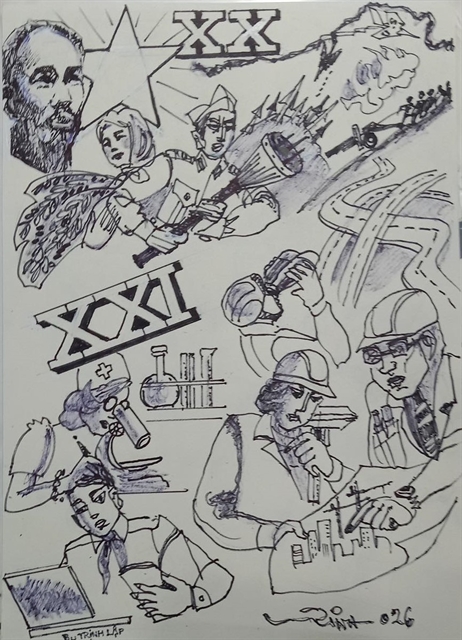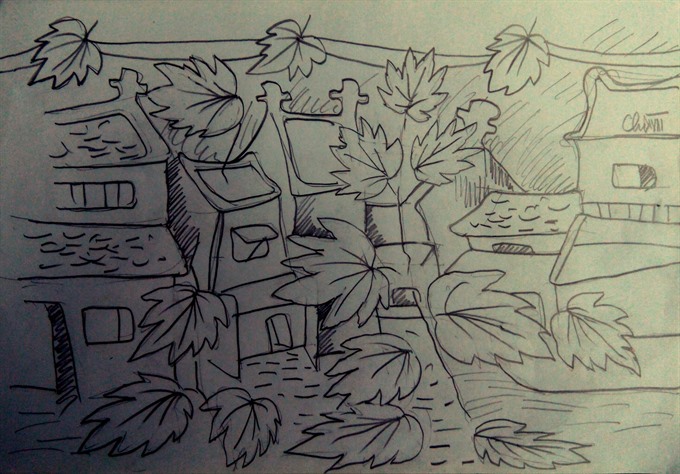 Talk Around Town
Talk Around Town

Imagination is a good thing till it runs riot in the wrong places.
 |
Khánh Dương
Imagination is a good thing till it runs riot in the wrong places.
Authorities in Hà Nội want us to imagine walking or riding bikes or driving a car on streets lined with maple trees with red leaves, evoking popular images we have of places like Europe.
Chairman of the municipal People’s Committee, Nguyễn Đức Chung, has promised to “bring the colour of European maples to the tropical land.”
I have nothing against red maples (acer rebrum) per se, but I am baffled by this addition of colour to a city official who has embarked on a praiseworthy plan to plant a million trees in the capital city to improve air quality and the urban landscape.
Why do we need to bring a tree that is not a natural fit? What sense does it make to expend extra effort, not to mention money, on such a venture?
As of now, thankfully, it is only a pilot project. A 100 red maple trees have been planted two to three metres from each other on the median strips of Trần Duy Hưng, Nguyễn Chí Thanh and Láng Hạ streets. It has been reported that this project is sponsored by someone or some entity.
“We need time to follow up on the tree’s growth. If it is suitable, we will multiply the planting,” Nguyễn Đức Mạnh, director of Hà Nội’s Green Tree and Park Joint Stock Company, told local media.
Many Hanoians are watching this project with interest, and many of them favour the plan to give the city a dash of “European colour” (and flavour, I guess). But there are also those who have taken umbrage at a hasty decision that could well prove to be a waste of time and money.
Forestry expert Đoàn Diễm says it is not easy for red maples, a temperate plant, to adapt to tropical climate, especially in the summer.
There is no information about a previous trial with maples in Việt Nam, especially in urban zones like Hà Nội. Experts are not too enthused about the idea.
Đỗ Văn Trung, director of Đức Lộc Green Tree Company who has studied red maples for ten years, said that leaves are so thin that they can be easily burn in the summer sun.
“Leaves of red maples planted in Hà Nội will not have beautiful color like those in Europe. It is better to plant such trees in mountainous area or at locations with high humidity like Sa Pa, Đà Lạt,” he said.
Some people have said that the trees must have been tested in parks first, rather than on the street. Red maples’ leaves will fall to the road in the heat and cause traffic problems if they are planted on medians, said Professor Lê Đình Khả, former director of Vietnamese Academy of Forest Sciences.
Then there are those who are very positive and upbeat. Nguyễn Lân Hùng, general secretary of the Union of Biology Associations, strongly believes in the red maple’s growth, saying they have been planted in some southern Chinese provinces with weather conditions not too different from Hà Nội.
“Red maples will survive,” he said.
The arguments over red maples reminded me of the controversy that broke out over a decision to chop down trees in the capital city.
Nearly two years ago in March 2015, the city started implementing a project to chop down and replant 6,700 trees, and almost 400 of them on Nguyễn Chí Thanh Street, well known as “the most beautiful street in Hà Nội” for the rows of tall, shady trees, were chopped down. Many of the trees were still in good condition and posed no traffic obstruction. The local Construction Department’s argument was that the trees were of 15 different varieties and had to be replaced with just one on one street.
Naturally, this rationale was met with outrage, which only grew when it was found out that the replacement tree, which was first said to be vàng tâm (Magnolia fordiana), turned out to be gỗ mỡ (Magnolia conifera), a shorter tree with smaller trunks and shade. Under public pressure, the tree renovation and replacement project was halted. Five months later, in August 2015, the authorities “corrected the mistake” by replacing gỗ mỡ trees with lát hoa trees, said to grow very quickly and be resistant to rains and storms.
Less than a year later, a heavy storm uprooted more than 1,000 trees, including the newly planted lát hoa trees, in just one night. Many of the uprooted trees had roots still covered in plastic bags, showing carelessness in planting.
It should be mentioned here that these mistakes cost the city a lot, in terms of lost trees and wasted money. One day in the summer of 2016, Hanoians were suddenly informed that that grass cutting and plant trimming in the city would be suspended because local authorities were spending over VNĐ700 billion (US$30.5 million) on the task each year. The suspension laid off more than 400 workers. Three months after the “trial suspension”, the trimming resumed with the budget trimmed to about VNĐ178 billion ($7.7 million) per year.
Such experiences have diminished public trust in the city’s officials. We can safely say that residents of the capital city are nervous and anxious about the fate of age-old trees in the hands of authorities who’ve shown themselves prone to take decisions that are not well thought out.
For me, the red maple controversy has also stemmed from an ill-considered venture. Will these trees go the way of vàng tâm, gỗ mỡ and lát hoa trees?
Every Hanoian wants a green city with green spaces that the capital has lost to urban construction. There is no reason for us to look like some other city. We can appreciate other cities, in Europe or elsewhere, and emulate what is good about their planning and implementation processes. But trying to look like Europe will make us look like a cheap, fake copy. We have enough of original Vietnamese heritage, creativity and imagination make our city uniquely Hà Nội, not a copy.
In sum, every Hanoian will see red if the greening plans are not well thought out and end up wasting precious resources, including money.
The greatest loss of all will be public trust and confidence.
A Norwegian proverb says: “Wise men learn by other men’s mistakes and fools by their own.” — VNS




